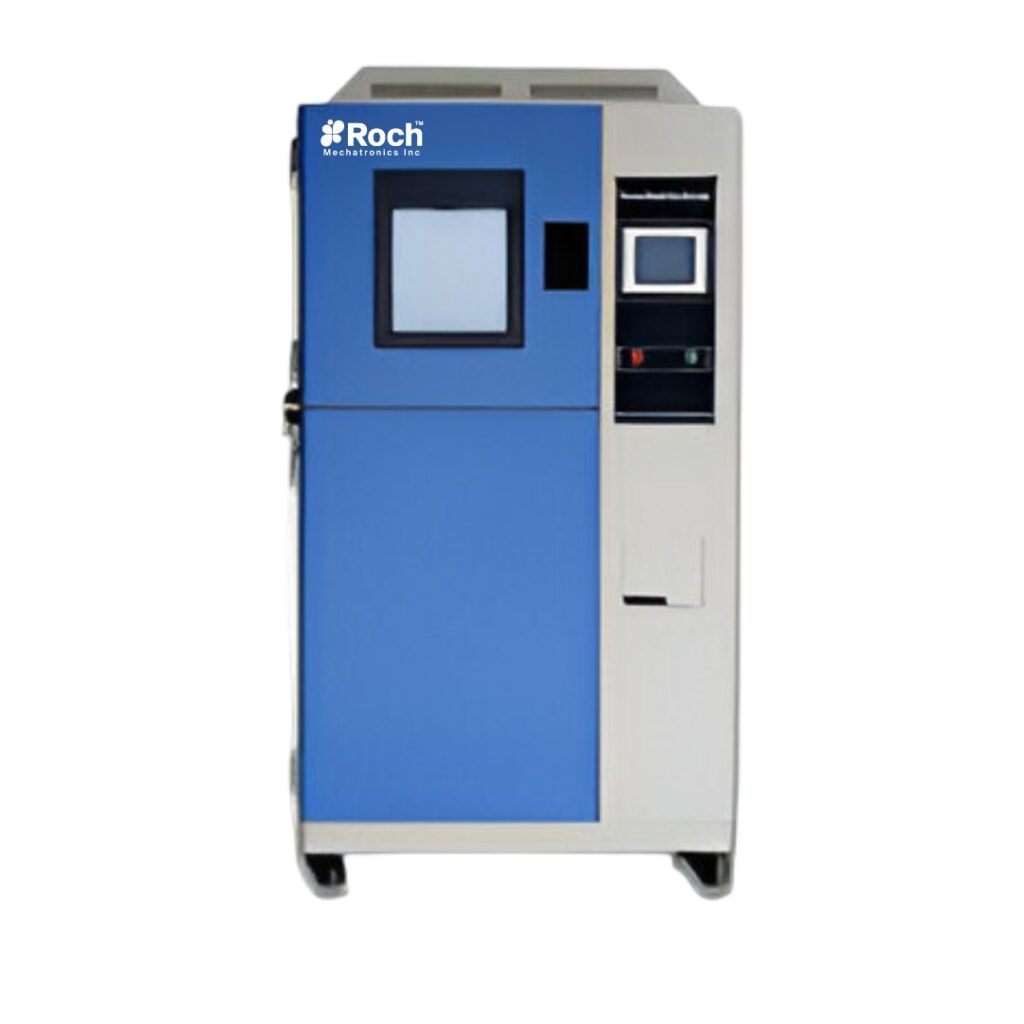Thermal Shock Test Chamber Manufacturers
Roch Mechatronics Inc. offers high-performance thermal shock chambers built with cutting-edge technology, robust construction, and precise control systems. Our chambers typically feature dual or triple-zone configurations (hot zone, cold zone, and ambient zone), fast temperature transfer rates, and programmable cycling, making them ideal for accelerated life testing and thermal fatigue analysis.
Whether it’s electronic components, circuit boards, plastics, or composite materials—our systems ensure reliable and repeatable results for your R&D or quality control processes. We focus on innovation, energy efficiency, and ease of use, backed by a responsive service and support network.

Features of Thermal Shock Test Chamber Services:
- A vertical-orientation Orientation Thermal Shock Chamber has two independently controlled hot and cold zones; one atop the other.
- A single product carrier moves between each zone, subjecting the product to dramatic changes in temperature.
- An advantage of the Vertical Orientation chamber is that it uses less floor space, making it ideal for smaller labs.
- A horizontal-orientation thermal shock chamber has three side-by-side independent zones: hot, ambient, and cold.
- The addition of the ambient zone allows for three-zone testing, which is a requirement of some military standards.
Working Principle of a Thermal Shock Chamber
A Thermal Shock Chamber operates on the principle of rapidly transferring a test specimen between extreme temperature environments to evaluate its structural and functional integrity. It simulates sudden thermal transitions that materials or components may encounter in real-world applications.Dual or Triple Zones:
The chamber is divided into two or three separate temperature zones—hot, cold, and sometimes an ambient zone.
Rapid Transfer:
The test specimen is quickly moved (either by a basket transfer or air damper system) from one temperature zone to another, typically within seconds.
Extreme Temperature Exposure:
The hot zone may reach temperatures up to +200°C.
The cold zone may drop to -70°C or lower.
The test sample is held in each zone for a defined period to simulate thermal stress.
Our Products
Thermal Expansion & Contraction:
Repeated cycling between hot and cold zones forces materials to expand and contract rapidly, mimicking real-life environmental changes.
Observation & Analysis:
This rapid cycling helps identify thermal fatigue, cracking, material deformation, or functional failure in electronic parts, composites, plastics, and metals.
Liquid To Liquid Thermal Shock Test Chamber
A Liquid-to-Liquid Thermal Shock Chamber is a specialized environmental testing system designed to assess the durability and performance of components exposed to extreme and rapid liquid temperature changes. Unlike air-to-air chambers, this type immerses test specimens directly into hot and cold liquid baths, ensuring faster thermal transfer and greater stress intensity on the materials.

Thermal Shock Test Chamber Price
Here’s a simple chart displaying approximate price ranges of Thermal Shock Test Chambers based on type and specifications:
| Type of Thermal Shock Chamber | Temperature Range | Zone Type | Approx. Price (INR) | Approx. Price (USD) |
|---|---|---|---|---|
| Basic 2-Zone Air-to-Air Chamber | -40°C to +150°C | Dual Zone | ₹60,000 – ₹5,00,000 | $700 – $6,000 |
| Standard 3-Zone Thermal Shock Chamber | -70°C to +200°C | Triple Zone | ₹5,00,000 – ₹15,00,000 | $6,000 – $18,000 |
| High-Capacity Industrial Chamber | -75°C to +250°C | Triple Zone | ₹15,00,000 – ₹30,00,000 | $18,000 – $36,000 |
| Liquid-to-Liquid Thermal Shock Chamber | -65°C to +150°C | Dual Liquid Zone | ₹30,00,000 – ₹40,00,000+ | $36,000 – $48,000+ |
Specification
| Specification | Details |
|---|---|
| Chamber Type | 2-Zone (Hot/Cold) or 3-Zone (Hot/Cold/Ambient) |
| Temperature Range (Cold Zone) | -70°C to -10°C |
| Temperature Range (Hot Zone) | +60°C to +200°C |
| Transfer Time | ≤10 seconds (between zones) |
| Recovery Time | ≤5 minutes (to stabilize after transfer) |
| Chamber Capacity | 20 to 1000 liters or more |
| Temperature Fluctuation | ±1.0°C |
| Temperature Uniformity | ±2.0°C |
| Cycle Time | Programmable (number of cycles, dwell time) |
| Cooling System | Air-cooled or Water-cooled |
| Compressor Type | Hermetic/semi-hermetic scroll or piston |
| Controller | Programmable PLC or Touchscreen HMI |
| Safety Features | Overheat protection, circuit breakers, alarms |
| Power Supply | 3-Phase, 415V, 50/60Hz (or customizable) |
| Material (Interior/Exterior) | Stainless Steel SUS 304 / Powder-coated Steel |
#No.1 Best Manufacturer and Supplier
At Roch Mechatronics Inc., we proudly stand as the No.1 best manufacturer and supplier of precision-engineered environmental test chambers in India.At Roch Mechatronics Inc., we don’t just manufacture test chambers, we engineer confidence into your product development cycle With a strong focus on quality, innovation, and on-time delivery, we specialize in cutting-edge solutions like Thermal Shock Chambers, , Humidity Chambers, Environmental Test Chamber Manufacturers and Climatic Chamber Manufacturers and more. Our commitment to excellence and client satisfaction has positioned us as the trusted name across industries including automotive, aerospace, electronics, and defense.
